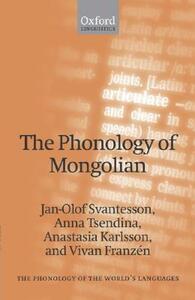Take a photo of a barcode or cover
2 reviews for:
The Phonology of Mongolian
Jan-Olof Svantesson, Anastasia Karlsson, Vivan Franzén, Anna Tsendina
2 reviews for:
The Phonology of Mongolian
Jan-Olof Svantesson, Anastasia Karlsson, Vivan Franzén, Anna Tsendina
Entries in the Oxford University Press series The Phonology of the World's Languages often treat the language in question in a fashion that is rigorous and in-depth but generally synchronic. This volume of Mongolian initially continues that trend, amply describing the phonology of modern Khalkha Mongolian. This part of the book is helpful in getting past the misleading Cyrillic script and understanding how Khalkha is actually pronounced, with its intricate syllabification rules, pharyngeal vowel harmony and aspirated/unaspirated distinction in the stops.
However, in a delightful turn, the authors spend most of the book (pages 98-217) reconstructing the phonological system of Old and Middle Mongolian by examining the four scripts used for the language as it appeared on the historical stage. They then show how a number of modern Mongolic languages – and not just Khalkha – derive from Middle Mongolian through various processes. In that respect The Phonology of Mongolian replaces Nicholas Poppe's venerable Introduction to Mongolian Comparative Studies from 1955, and along with Routledge's The Mongolic Languages and Jahunen's Mongolian it is one of the first stops for anyone interested in the Mongolic language family. It is a fresh and original look at one of the cornerstones of Altaic linguistics, and I was intrigued by how the authors reconstruct the aspirated/unaspirated distinction in the stops back to early Mongolic.
However, in a delightful turn, the authors spend most of the book (pages 98-217) reconstructing the phonological system of Old and Middle Mongolian by examining the four scripts used for the language as it appeared on the historical stage. They then show how a number of modern Mongolic languages – and not just Khalkha – derive from Middle Mongolian through various processes. In that respect The Phonology of Mongolian replaces Nicholas Poppe's venerable Introduction to Mongolian Comparative Studies from 1955, and along with Routledge's The Mongolic Languages and Jahunen's Mongolian it is one of the first stops for anyone interested in the Mongolic language family. It is a fresh and original look at one of the cornerstones of Altaic linguistics, and I was intrigued by how the authors reconstruct the aspirated/unaspirated distinction in the stops back to early Mongolic.

